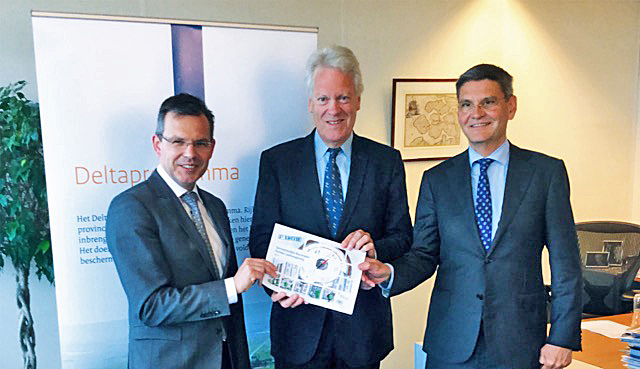Implementation of the 21st century Delta Plan
Eighty-three percent of Dutch municipalities regard flooding due to heavy rain as the most urgent climate problem. This was one of the results of the report entitled Gemeentelijke Barometer van de Fysieke Leefomgeving (Municipal Barometer of the Physical Living Environment) drawn up by engineering and consultancy firm Royal HaskoningDHV and the Association of Netherlands Municipalities (VNG). Over half the municipalities expect climate problems to increase in the years ahead. To limit pluvial flooding, 8 out of 10 municipalities state that sewerage tax may be increased.

The Gemeentelijke Barometer is an annual study that provides municipalities with insight into the latest trends, problems and developments involving the physical living environment. The 2015 edition, the first copy of which was presented to Delta Commissioner Wim Kuijken, examines in detail the theme of water and climate adaptation. The study involved 185 municipalities.
Vulnerable locations mapped in ninety percent of municipalities
Dutch municipalities and other authorities signed the Delta Programme administrative agreement last year on Prinsjesdag (the state opening of parliament in September). The document includes the aim that by 2050 the Netherlands will be as climate-proof and water-resilient as possible. Seventy-two percent of the municipalities have now set concrete objectives aimed at achieving this goal. Ninety percent of the municipalities have mapped the objects and locations that are vulnerable to rain-related flooding. Wim Kuijken: ‘Making our country climate-proof and water-resilient is one of the greatest challenges the Delta Programme is facing. Our work must be completed by 2050. This requires a great effort by all parties involved. Many measures and decisions, sometimes at the plot level, will contribute to achieving this aim. The municipalities will play a guiding role. I will deliver a progress report every year on Prinsjesdag.’
Intensified collaboration with the water chain
Municipalities are working actively with other water-chain partners (such as drinking water companies and water authorities) in capturing excess rainwater. Currently, 75 percent of municipalities are collaborating closely with partners; last year the figure was only 49 percent. The major driver behind this is cost efficiency. Knowledge development and lower costs are the most important results of this collaboration.